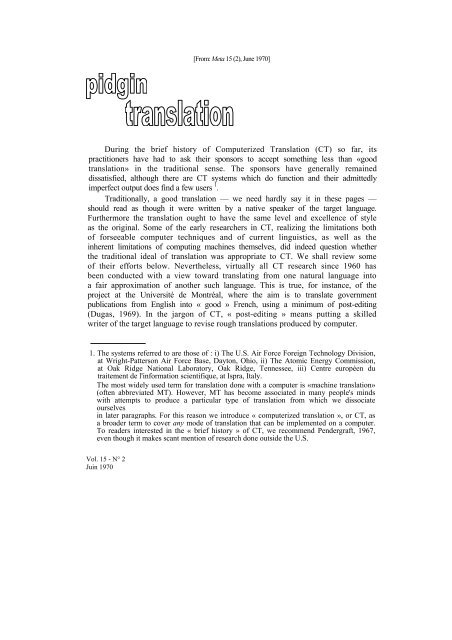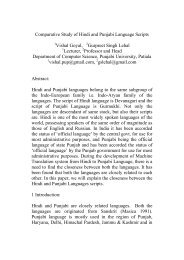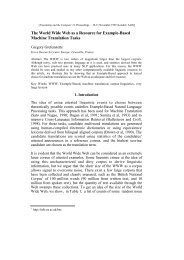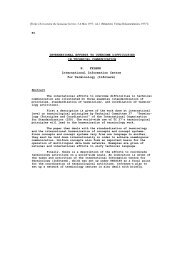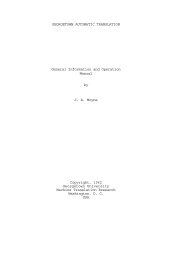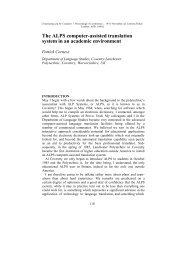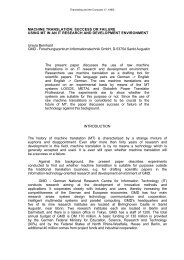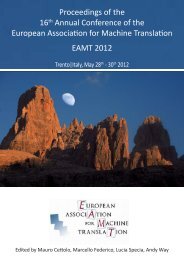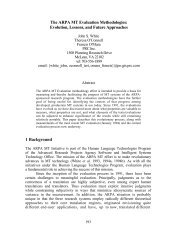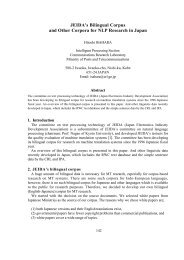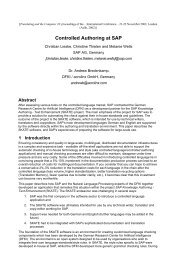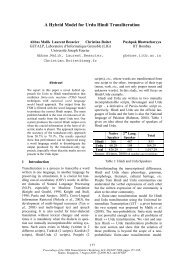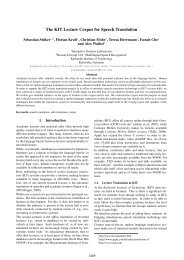pidgin translation - Machine Translation Archive
pidgin translation - Machine Translation Archive
pidgin translation - Machine Translation Archive
Create successful ePaper yourself
Turn your PDF publications into a flip-book with our unique Google optimized e-Paper software.
[From: Meta 15 (2), June 1970]<br />
During the brief history of Computerized <strong>Translation</strong> (CT) so far, its<br />
practitioners have had to ask their sponsors to accept something less than «good<br />
<strong>translation</strong>» in the traditional sense. The sponsors have generally remained<br />
dissatisfied, although there are CT systems which do function and their admittedly<br />
imperfect output does find a few users 1 .<br />
Traditionally, a good <strong>translation</strong> — we need hardly say it in these pages —<br />
should read as though it were written by a native speaker of the target language.<br />
Furthermore the <strong>translation</strong> ought to have the same level and excellence of style<br />
as the original. Some of the early researchers in CT, realizing the limitations both<br />
of forseeable computer techniques and of current linguistics, as well as the<br />
inherent limitations of computing machines themselves, did indeed question whether<br />
the traditional ideal of <strong>translation</strong> was appropriate to CT. We shall review some<br />
of their efforts below. Nevertheless, virtually all CT research since 1960 has<br />
been conducted with a view toward translating from one natural language into<br />
a fair approximation of another such language. This is true, for instance, of the<br />
project at the Université de Montréal, where the aim is to translate government<br />
publications from English into « good » French, using a minimum of post-editing<br />
(Dugas, 1969). In the jargon of CT, « post-editing » means putting a skilled<br />
writer of the target language to revise rough <strong>translation</strong>s produced by computer.<br />
1. The systems referred to are those of : i) The U.S. Air Force Foreign Technology Division,<br />
at Wright-Patterson Air Force Base, Dayton, Ohio, ii) The Atomic Energy Commission,<br />
at Oak Ridge National Laboratory, Oak Ridge, Tennessee, iii) Centre européen du<br />
traitement de l'information scientifique, at Ispra, Italy.<br />
The most widely used term for <strong>translation</strong> done with a computer is «machine <strong>translation</strong>»<br />
(often abbreviated MT). However, MT has become associated in many people's minds<br />
with attempts to produce a particular type of <strong>translation</strong> from which we dissociate<br />
ourselves<br />
in later paragraphs. For this reason we introduce « computerized <strong>translation</strong> », or CT, as<br />
a broader term to cover any mode of <strong>translation</strong> that can be implemented on a computer.<br />
To readers interested in the « brief history » of CT, we recommend Pendergraft, 1967,<br />
even though it makes scant mention of research done outside the U.S.<br />
Vol. 15 - N° 2<br />
Juin 1970
72 META<br />
Although one may sometimes lose sight of the fact, even <strong>translation</strong>s done<br />
by humans do not always reach the high standard that professional translators<br />
set themselves. In wide areas throughout the world, speakers having something<br />
less than mastery of a useful second language nevertheless manage to make<br />
themselves understood in it. Whole communities of these imperfect polyglots<br />
have developed mongrel tongues called generically « <strong>pidgin</strong>s » (Hall, 1954 2 ).<br />
Not only is the grammar of a <strong>pidgin</strong> English simplified from that of standard<br />
English, but a linguist can always detect considerable influence of the speaker's<br />
mother tongue on the <strong>pidgin</strong>. Thus the Chinese who asks for two piecee apple<br />
(2 apples) or the French speaker who says me, I am not in agreement (personally,<br />
I don't agree) is recognizably carrying over features of his native language into<br />
his « English ».<br />
However, we are not concerned with spoken <strong>pidgin</strong> in this article beyond<br />
showing why the term <strong>pidgin</strong> can be loosely applied to <strong>translation</strong>s already<br />
produced by CT, and to artificial language intended for CT production in the<br />
future. Masterman observed pithily that « machine <strong>translation</strong> always is a <strong>pidgin</strong> »<br />
(Masterman, 1967). She meant that the output from CT systems shows all too<br />
obvious vestiges of the language being translated. But this kind of <strong>pidgin</strong> is<br />
involuntary and unprincipled. It is therefore essentially different from what we<br />
have in view.<br />
Great problems still face anyone who aims to make CT rival traditional<br />
<strong>translation</strong>; to some of these problems no early solution can be expected (Bar-<br />
Hillel, 1964; Hofmann, 1968a). Consequently it is still worth discussing and<br />
investigating simpler kinds of <strong>translation</strong>. Taking a look first at traditional<br />
<strong>translation</strong>, we consider that it attempts a twofold task :<br />
a) to convey the cognitive meaning of the original;<br />
b) to re-express this meaning in a version of the target language that is<br />
stylistically acceptable, without losing any of the emotional and evaluative<br />
overtones imparted by nuances in the original.<br />
CT has typically been sponsored for the sake of obtaining speedy <strong>translation</strong>s<br />
of scientific and technical documents. For this purpose, task a) is far more<br />
important than b). We assert therefore that the prime requirement for CT products<br />
that their content should be understood by the readers for whom they are intended;<br />
one's feeling about the style of expression is, to say the least, a secondary<br />
consideration.<br />
In the past, CT researchers have not expected their readers to undergo any<br />
special training at reading the <strong>translation</strong>s in spite of some unaccustomed features<br />
in them. In some of the early systems, for instance, problems of ambiguity were<br />
partially overcome by the expedient of printing out small sets of alternative<br />
<strong>translation</strong>s and leaving readers to choose among them. This did not prove<br />
popular, presumably because « a reader is less confused by a text containing<br />
occasional vague equivalents than by one containing all the possible equivalents of<br />
2. The distinction between <strong>pidgin</strong>s and Creoles does not concern us here.<br />
Vol. 15 - N° 2<br />
Juin 1970
PIDGIN TRANSLATION 73<br />
every word » (IBM, 1959, Vol. 6, p. 3). Such success as CT has had, has been<br />
due to the nature of the texts selected for <strong>translation</strong>: the choice has ensured<br />
that the readership be limited to people with a good background knowledge of<br />
the subject treated. It has been shown that such readers are capable of extracting<br />
some worthwhile information even from very defective CT <strong>translation</strong>s 3 . Even so,<br />
why do readers accept inferior <strong>translation</strong>s which they can only understand in part ?<br />
The alternatives open to them are:<br />
1) To press for human <strong>translation</strong>s. These ought to be better, but they take<br />
considerably longer to produce. Speed is the very raison d'être of CT.<br />
2) To learn the language of the original. This, however, would practically<br />
oblige the researcher to learn as many languages as are used to publish original<br />
articles in his field — an awesome task even for linguists. Moreover some languages<br />
important for a researcher, for example those with different writing systems<br />
from his own, present exceptional difficulties to the learner in a hurry.<br />
These objections lead us to pose a question that is all-important if one is to<br />
appreciate the usefulness of <strong>translation</strong> into <strong>pidgin</strong>-like languages. Is it better to<br />
delay for months, perhaps years, in order to learn a foreign language; or to<br />
spend a few hours, even days, getting used to the peculiarities of <strong>pidgin</strong> English<br />
or <strong>pidgin</strong> French? Many people in <strong>pidgin</strong>-speaking areas of the world have<br />
already found that, for practical purposes, <strong>pidgin</strong> will do.<br />
On the other hand, not all CT researchers expect their <strong>translation</strong>s to be<br />
handed « raw » to readers. The U S. Air Force system uses extensive post-editing,<br />
while Booth describes her research at the University of Saskatchewan as « machine<br />
aided <strong>translation</strong> with a post-editor » (Booth, 1967b). The drawbacks are<br />
obviously that skilled human intervention is still required for the post-editing, and<br />
that some of the time saved by CT is lost again. Rather than spend large sums<br />
on CT research, would it not be better to spend it on training more translators,<br />
who could make a <strong>translation</strong> from the source just as quickly as they could<br />
revise a poor CT one? The answer to this criticism lies in the present shortage<br />
of translators coupled with the ever growing volume of <strong>translation</strong> to be done.<br />
There are grave shortcomings even with English and French in Canada, where<br />
there is a reserve of bilinguals who can be used as translators. Consider then<br />
the problems of translating Chinese scientific reports. Yet Chinese currently<br />
presents one of the most urgent <strong>translation</strong> problems in the U.S. (See, 1967).<br />
When bilingual people are scarce it should be particularly valuable to have a<br />
CT system providing adequate raw <strong>translation</strong>s for polishing by monolingual<br />
post-editors, who ought to be more readily obtainable.<br />
3. Carroll, 1966; Orr, 1967. The latest evaluation to come to hand is the following claim<br />
for the system now in operation at the Euratom centre at Ispra in Italy : « A Ispra, les tra-<br />
ductions sont livrées aux clients sans révision. Bien que la qualité des traductions ne<br />
puisse être consideree comme parfaite, elle semble néanmoins adéquate aux exigences de<br />
l'information, puisque les clients n'ont pas fait usage de la faculté qui leur est offerte<br />
d'une traduction « humaine » des textes, dans le cas où ils ne seraient pas satisfaits de<br />
la traduction automatique. » (Perschke, 1968).<br />
Vol. 15 -- N° 2<br />
Juin 1970
74 META<br />
However, it is always difficult for a post-editor to understand a rough<br />
<strong>translation</strong> which does not convey all the content of the original. Interpretive<br />
help may be provided by background knowledge of the subject matter or by<br />
sheer professional experience as a translator, but there is the constant danger<br />
of misinterpreting. For this reason, we consider that a satisfactory rough <strong>translation</strong><br />
intended for post-editing must conserve all of the semantic and grammatical<br />
information contained in the original. We pursue this ideal below in the proposals<br />
for « specific <strong>pidgin</strong> » (see also Hofmann, 1968b).<br />
As for the current output from CT systems, Masterman's complaint that<br />
its « characteristics per se are never investigated » is as apt today as when she<br />
first made it ten years ago (Masterman, 1967 4 ). True, there have been<br />
investigations in which « consumer opinion » was tested; but the test material<br />
was a product with the arbitrary merits and defects that resulted from an<br />
existing system. So far as we know, the problem has never been looked at the<br />
other way round, which is to test readers with deliberately designed « simplified »<br />
<strong>translation</strong>s before designing the system that would produce them.<br />
Sponsors of future CT projects would be well advised to avoid the « hit or<br />
miss » approach typical of most CT projects to date by attending first to the goals:<br />
what is minimally acceptable, and how much tolerance readers show for various<br />
ways in which CT output may deviate from a man-made <strong>translation</strong> par excellence.<br />
With these goals duly specified, CT could become an engineering problem to which<br />
the criterion of the cost-quality relationship could be effectively applied. We shall<br />
claim below that human readers can tolerate considerable lack of quality provided<br />
certain conditions are fulfilled 5 .<br />
II<br />
Mark Twain said in a speech to the Vienna Press Club :<br />
I am indeed the truest friend of the German Language — not not only now,<br />
but from long since — yes, before 20 years already... I would only some<br />
changes effect. I would only the language method — the luxurious, elaborate<br />
construction compress, the eternal parenthesis suppress, do away with,<br />
annihilate; the introduction of more than thirteen subjects in one sentence<br />
forbid; the verb so far to the front pull that one it without a telescope<br />
discover can. With one word, my gentlemen, I would your beloved language<br />
simplify so that, my gentlemen, when you her for prayer need, One her<br />
yonder-up understands.<br />
...I might gladly the separable verb also a little bit reform. I might none<br />
let do what Schiller did; he has the whole history of the 30 Years' War<br />
between the two members of a separable verb in-pushed. That has even<br />
4. Most of Masterman's article was actually written in 1960 : see her footnote, p. 197.<br />
5. Numerous writers have criticized man's natural tendency to try and make computers<br />
simulate man. One could cite Arthur C. Clarke, Wayne Danielson, and the Sedelows.<br />
Meanwhile the few remaining sponsors of CT still hope that the computer will produce<br />
<strong>translation</strong>s in the same sort of language as we are used to. « To require computer-generated<br />
language to conform in detail to all, or most, of a human's linguistic conventions is ana-<br />
logous to requiring early printers to make their output resemble manuscript writing.<br />
Initially, just such « magic realism » may be demanded, to demonstrate the machine's true<br />
virtuosity and intelligence as well as to fully achieve communication. Later we may<br />
learn to accept as satisfactory very different output language from the computer. »<br />
(Sedelow, 1967, p. 210).<br />
Vol. 15 - No 2<br />
Juin 1970
PIDGIN TRANSLATION 75<br />
Germany itself aroused, and one has Schiller the permission refused the<br />
History of 100 Years' War to compose — God be it thanked! After all these<br />
reforms established be will, will the German language the noblest and the<br />
prettiest in the world be.<br />
(quoted in BB&N, 1966)<br />
This passage was meant to satirize the extremes of dissimilarity between<br />
German and English syntax, yet it is quite easy to understand; and it illustrates<br />
how quickly a reader can become accustomed to a very different word order.<br />
In the first section of this article we said that people can and often do make<br />
use of « compromise languages », i.e. <strong>pidgin</strong>s, when the only goal is the exchange<br />
of practical information. And reviewing the difficulties encountered in trying to<br />
translate by computer, we suggested that the machine might convert a text written<br />
in one language into a <strong>pidgin</strong>-like language similar enough to another language<br />
for the <strong>pidgin</strong> to be read with little training by speakers of that other language.<br />
Furthermore such a <strong>pidgin</strong> might be suitable for rewriting into a stylistically<br />
acceptable form of the target language by a post-editor who did not know the<br />
source language. In this section, we want to propose a definition of an ideal<br />
<strong>pidgin</strong> which we shall call « specific <strong>pidgin</strong> », and from it we may draw certain<br />
conclusions about the feasibility of <strong>pidgin</strong> <strong>translation</strong>.<br />
We can speak of the process and the product of <strong>pidgin</strong> <strong>translation</strong> apart<br />
from the computer implementation of it. Let us then delay any further mention<br />
of the computer until after we have taken a closer look at the product and its<br />
virtues, and have related these to the work of our precursors.<br />
Specific <strong>pidgin</strong> <strong>translation</strong> is characterized by three constraints:<br />
1) Very nearly all of the meaningful elements in the text after <strong>translation</strong><br />
are composed of target language words.<br />
2) A single target language word (or phrase) is used in all contexts to<br />
translate each source language word. For a source word which has several<br />
distinguishable meanings (polysemes), one tries to find a target language word<br />
which comes close to covering all of them; as a last resort one might create a<br />
new word out of morphemes of the target language and assign just these meanings<br />
to it (as suggested in Masterman, 1967).<br />
3) No information present in the syntax or the lexical contrasts of the<br />
source language is lost in <strong>translation</strong>.<br />
Natural <strong>pidgin</strong> languages exhibit characteristics which, though they are<br />
much less rigid, correspond to our proposed constraints; that is why we call<br />
<strong>translation</strong> of this nature « <strong>pidgin</strong> <strong>translation</strong> 6 ». We further qualify our proposed<br />
variety as « specific » to distinguish it from the unspecific or universal <strong>pidgin</strong><br />
<strong>translation</strong> proposed by Richens and Booth (Richens, 1955) and later « sophisti-<br />
cated » by Masterman (Masterman, 1967). Their versions were « unspecific » in<br />
6. Note especially that the syntactic structures and lexical contrasts in the <strong>pidgin</strong> will be<br />
those of the source language. So Caribbean créole usually sounds degenerate to French<br />
speakers from other areas because they cannot help recognizing most of the words in it<br />
as French but they are ignorant of all that is imparted by its Afro-Caribbean substratum.<br />
Likewise any of our <strong>pidgin</strong>s may seem degenerate, but only until the reader comes to<br />
acquire its source structure by using it.<br />
Vol. 15 — N° 2<br />
Juin 1970
76 META<br />
the sense that these earlier workers translated from a number of source languages<br />
into a similar number of English-like <strong>pidgin</strong>s and then compressed all the <strong>pidgin</strong>s<br />
into a single language. They thereby destroyed a considerable amount of<br />
information carried by lexical contrasts in the source languages. As an example<br />
of lexical contrast in English, we may cite the choice of ask instead of demand<br />
or request; we would insist that these three be translated by three distinct words<br />
in a specific <strong>pidgin</strong>. In addition to losing lexical information, our precursors also<br />
destroyed most of the grammatical information: the grammars of different languages<br />
are sufficiently different that if several grammars are conflated the result is no<br />
grammar at all, just strings of unrelated words. Even in the case systems, much<br />
of the distinctive information was destroyed: for instance, in making <strong>pidgin</strong><br />
English from German and Russian, which both have a dative case, both datives<br />
were represented in the <strong>pidgin</strong> by d in spite of the fact that they are used quite<br />
differently in their respective languages. The remaining grammatical information<br />
was further reduced by discarding important grammatical suffixes altogether if<br />
they were not easily disambiguated 7 .<br />
Richens and Booth employed the « most frequently used equivalent » to<br />
translate lexical items. We would criticize this on two counts: first, the <strong>translation</strong><br />
so chosen for one source word (its « translate ») could be also chosen for another<br />
source word, thus losing information about the lexical choices made by the author;<br />
and secondly, it often happened that a word's translate did not have all or even<br />
most of that word's meanings and could thereby prove quite inappropriate in<br />
some contexts. To avoid this deterioration, we impose on our type of <strong>pidgin</strong> an<br />
additional but less rigid requirement that:<br />
4) A translate need not be a frequent word in the target language, but its<br />
range of meanings must match as closely as possible the range of meanings of the<br />
source word it stands for.<br />
This constraint is nicely exemplified by the French word langue. It has two<br />
principal meanings, one translatable into English as language, the other as tongue.<br />
Even though the word tongue has an archaic flavour when used to mean « lan-<br />
guage », the more important consideration for our purpose is whether the resultant<br />
<strong>translation</strong>s can be understood. Thus, using language as the translate allows<br />
correctly The study of languages is interesting but also the horribly incorrect<br />
He stuck his language out of his mouth. Using tongue as the translate for langue<br />
admits unusual <strong>translation</strong>s, but they are always understandable: The study of<br />
tongues is interesting. He stuck his tongue out of his mouth.<br />
Richens and Booth used multiple translates to stand for a single source<br />
language word which had widely divergent meanings, i.e. they presented alternative<br />
translates to the reader, who had to chose among them. While this seems a<br />
reasonable thing to do and probably does aid the novice reader, it is ruled out<br />
by our conception of <strong>pidgin</strong> <strong>translation</strong>. Moreover it has been found detrimental<br />
to understanding, as we mentioned earlier; and in any case, after reading a<br />
7. Richens and Booth reduced all such information to v (vacuous) or z (unspecific), while<br />
Masterman went further and deleted these marks as useless and confusing.<br />
Vol. 15 — N° 2<br />
Juin 1970
PIDGIN TRANSLATION 77<br />
few paragraphs a reader is no longer a novice. Masterman realized how clumsy<br />
multiple translates were and avoided them by several techniques 8 .<br />
Yet in spite of the objections made here, the <strong>translation</strong>s by Richens and<br />
Booth were surprisingly readable, and Masterman's were even more so. With<br />
the constraints we propose, we do not expect readability to be so good for a<br />
person who is scanning a specific <strong>pidgin</strong> for the first time; but for reasons we<br />
shall expand on later, his performance should go on improving indefinitely with<br />
practice. Briefly the earlier <strong>pidgin</strong>s lacked that fidelity to a natural source language<br />
which in our case would allow the reader to decode more with experience.<br />
Consequently he was unlikely to get much more information out of them than<br />
at his first encounter.<br />
We give great weight to the view that natural languages are subtly and<br />
intricately structured in such a way as to afford the human intellect both easy<br />
communication and easy learning. But given a biologically inherited language<br />
capability, what is « easy » for that capability need not be what seems simple<br />
or regular to our rational thought processes. This orientation leads us to formulate<br />
aims and techniques that differ significantly from those of the earlier <strong>pidgin</strong><br />
proponents. We feel that a specific <strong>pidgin</strong> <strong>translation</strong> must be constrained to<br />
match natural language structure closely until we receive experimental evidence<br />
that proposed deviations do not hinder communication or acquisition. Thus we<br />
resist the notion that simplifying the surface structure of a communication is<br />
necessarily an advantage; and we prefer to reproduce all the intricacies — even<br />
the « redundancies » — of the language of origin, although it may seem to English<br />
readers obviously expedient to clear away certain marks such as gender or case<br />
endings.<br />
III<br />
Like the earlier <strong>pidgin</strong> attempts, specific <strong>pidgin</strong> (henceforth just « Pidgin »,<br />
with a capital P, for short) grew from the idea of constructing artificial languages<br />
which it would be realistic to consider translating into by computer, yet would be<br />
easy for English speakers to learn. Bearing in mind this idea of Pidgins as new but<br />
easily learned languages, we shall now explore some of their possible applications.<br />
Pidgin <strong>translation</strong> might be employed in the following situations: when a<br />
researcher wants to read an article relating to the matter under investigation;<br />
when an expert wants to keep abreast of all the foreign literature in his field; and<br />
in the case of an agency interested in producing rapid <strong>translation</strong>s at minimal cost.<br />
Such agencies often call for preliminary rough <strong>translation</strong>s which are then<br />
polished by the most experienced translators. Pidgin CT might profitably be used<br />
to produce the rough drafts. In such a system, we would expect an interesting<br />
development: the translator, having been given both the Pidgin for polishing and<br />
8. She proposed the manufacture of « <strong>pidgin</strong> variables », words constructed out of English<br />
word-material to incorporate the semantic and syntactic properties of source words —<br />
usually grammatical function words — that were impossible to match otherwise. She also<br />
employed micro-glossaries (special dictionaries for technical jargons) and phrase-for-phrase<br />
<strong>translation</strong>s. We reserve judgement on the usefulness of micro-glossaries, but commend her<br />
invention of <strong>pidgin</strong> variables. We also believe that translating phrase for phrase is some-<br />
times justified.<br />
Vol. 15 - N° 2<br />
Juin 1970
78 META<br />
the original text to refer back to, would find himself looking less and less to the<br />
original text until he completely ignored it and worked entirely from the Pidgin.<br />
The reason for this prediction is that Pidgin text must by definition preserve all<br />
the information contained in the original. The translator would be bound to<br />
learn more and more of the correspondences between Pidgin words and the<br />
vocabulary of the source language, a process likely to be subconscious in the main.<br />
If he were pressed for time — and what translator is not? — he would certainly<br />
begin to exploit this knowledge and not look so frequently at the original text.<br />
In the French to English example given earlier, when he came across the Pidgin<br />
word tongue, he would have a strong expectation that if he looked in the original<br />
text he would find langue. This informal learning would continue until the<br />
translator did not look at the source text at all. But if an experienced translator<br />
can eventually dispense with source texts, is it essential or efficient to insist that<br />
newcomers should be able to read text in the source language in the first place?<br />
Indeed if, as we shall argue, it is easier to learn Pidgin than an original language,<br />
then it ought to be cheaper and faster to train a translator to translate from Pidgin<br />
English into English (or from Pidgin French into French) than to do real <strong>translation</strong>.<br />
And it being cheaper and faster to train people to translate from Pidgin, one would<br />
expect there to be an easier supply of them 9 .<br />
At the introduction of any new technology, people can fear the worst<br />
(« being made redundant by the computer ») or they can profit from the innovation.<br />
There is, of course, no immediate danger of redundancy; Pidgin <strong>translation</strong> would<br />
be most profitably applied to translating languages for which there is the most<br />
serious dearth of translators. And even taking the long view, there is little cause<br />
for worry, because in the forseeable future Pidgin is unlikely to be of value for<br />
<strong>translation</strong> involving literary merit: this will continue to require a person with<br />
excellent control of the target language and an acute sensitivity to the nuances<br />
in language of origin. It is a serious question whether a mechanical device can<br />
ever attain this; and even if it were possible, nobody yet has the slightest idea<br />
of how to build such a machine. However, we see Pidgin CT as offering to remove<br />
much of the drudgery of hack <strong>translation</strong> — the <strong>translation</strong> of material that is<br />
of indifferent stylistic quality, but which is necessary for everyday use. If this<br />
proved to be so, Pidgin <strong>translation</strong> would free the translator to apply himself<br />
to more rewarding tasks.<br />
We pointed out in Section I that any serious attempt to replace or aid<br />
human translators must begin with a realistic assessment of what aid translators<br />
need and of the needs of their readers; and that this essential first step has been<br />
overlooked by mechanical <strong>translation</strong> projects. As a contribution to this study,<br />
the concept of Pidgin offers a well-defined and reproducible standard level of<br />
<strong>translation</strong> — considering it for the moment to be <strong>translation</strong>, which it is after<br />
a fashion. It can be deviated from in measurable ways so as to determine the<br />
9. One might ask: if it is so easy to learn to read Pidgin <strong>translation</strong>s, why have them<br />
post-edited at all? Indeed we do believe that for specialist readers post-editing would be<br />
a waste of resources. Nonetheless, we accept that many documents, especially those for<br />
wide and general publication, have to be translated into normal language.<br />
Vol. 15 - N° 2<br />
Juin 1970
PIDGIN TRANSLATION 79<br />
effects of the deviation, and thereby allow measurement of the cost-effectiveness<br />
relationships for the various mechanizable processes of <strong>translation</strong>.<br />
In the first situation mentioned earlier, suppose a scientist has learned that<br />
a particular article in, say, a Chinese journal bears on the investigation he is<br />
undertaking. If he has recourse to the traditional translator he has little chance<br />
of satisfaction, for even with « common » languages like Russian or German he<br />
can expect a three month wait if not more (See, 1967), by which time he may<br />
either have duplicated successful research or wasted great effort in making mistakes<br />
that the report was intended to warn against. He is even more handicapped if<br />
an article is in a language for which there are few translators available, because<br />
not only does the delay increase but the quality usually decreases — to the point<br />
where the <strong>translation</strong> may be rendered worthless.<br />
Our specialist has an alternative which is far better if he has the time, namely<br />
to learn the foreign language himself. Universities have long recognized this<br />
desideratum and required a reading knowledge of several languages, but if the<br />
language is unfamiliar, then the practising scientist will have to delay his researches<br />
by the length of tune it takes to learn to at least read it. This may be as short<br />
as a few days for mathematics in a language similar to one he already knows,<br />
since mathematics do not involve so much textual reading and have a large<br />
international notation and vocabulary; or it may be as long as several years for a<br />
language as different as Chinese is from English. Most scientists, for obvious<br />
reasons, do not take this alternative unless there is a great deal of other interesting<br />
literature in the same language. Moreover, there is a strong tendency today to<br />
write in one's national language, and this threatens to increase scientists' language<br />
learning loads. For instance, there are linguists of repute writing today in Italian,<br />
Danish, Dutch, Russian, Polish, Bulgarian, Chinese, Swedish, Spanish, Japanese,<br />
Hebrew, etc., all in addition to the traditional French, English and German.<br />
Learning half the languages on this list would be an admirable accomplishment:<br />
in practice, scientists need an alternative both to learning numerous languages<br />
and to reliance on human translators.<br />
A more recent possibility, that of obtaining a mechanically translated (MT)<br />
version of the article, has yet to prove satisfactory, notwithstanding preliminary<br />
successes in the U.S. and Europe. Even with existing computers, MT is faster<br />
than manual <strong>translation</strong> and competitive in cost, but its products have been of<br />
value only for grasping the « gist » of an article 10 . It is true that with experience,<br />
a reader probably becomes familiar with the idiosyncracies of the translating<br />
machine and so his reading becomes easier and more accurate. He is inevitably<br />
10. This assertion about the cheapness of MT is disputable. The strongest evidence for the<br />
opposition was gathered in the « ALPAC Report » (ALPAC, 1966, Appendix 9, « Cost<br />
estimates of various types of <strong>translation</strong> », p. 54ff). But besides opinions which others<br />
have expressed counter to the Report, we doubt its present worth because computer hard-<br />
ware developments are all the time tending to make MT cheaper irrespective of its programs<br />
and linguistics. For example, one of the major expenses until now has been preparing<br />
the texts for input into the machine: usually it had to be punched on cards. Already<br />
optical scanners are coming onto the market which enable the computer to read directly<br />
from a typed page. The latest computers calculate about four times faster than the best<br />
five years ago.<br />
Vol. 15 - N° 2<br />
Juin 1970
80 META<br />
limited, however, by the lack of whatever information was lost in the <strong>translation</strong><br />
process. This is not to deny that MT is being improved by research. But the<br />
improvement is slow and requires very sophisticated efforts from linguists, from<br />
computer scientists, and eventually from researchers into artificial intelligence<br />
and information retrieval.<br />
Pidgin offers an alternative which is more accessible than either of the<br />
foregoing. It would cost less than MT because it would use less computer time.<br />
This is because the algorithms needed are comparatively simple: it only needs<br />
a dictionary look-up and perhaps a rough parsing to reduce the homographs,<br />
whereas effective MT must incorporate more complex transformational grammar<br />
for deeper semantic analysis of the source language, and also a synthesizer of the<br />
target language. No less important is the economy that Pidgin offers in the human<br />
resources needed to write the grammars and program the systems. The programmers<br />
for their part can already provide all that is needed for Pidgin CT. Pidgin removes<br />
the major obstacle to effective CT, namely that if a computer is to simulate<br />
conventional human <strong>translation</strong>, the machine has to understand the original text.<br />
In comparing Pidgin output with that of MT, we concede that it is less<br />
perspicuous to the beginner. We would therefore propose that he be given a few<br />
hints, as we have done for the Arabic example to follow. But after he has been<br />
helped to read and understand the first paragraphs, he ought to be able to go on<br />
by himself and get the gist of the article with a little effort. Thus, subject to<br />
some extra effort at the very outset, Pidgin <strong>translation</strong> should be at least as<br />
readable as MT output.<br />
To learn a Pidgin is clearly simpler and faster than learning the original<br />
language, if only because the task of learning the thousands of content words in<br />
a foreign vocabulary is mostly removed by drawing a Pidgin vocabulary from<br />
the reader's own language. So he already knows the meanings of most of the<br />
Pidgin words — not their exact semantic ranges but approximations. This follows<br />
from the constraints which we have stipulated. This much and no more already<br />
allows him to read roughly. What he must then learn by way of vocabulary is<br />
how people who speak the other language put these already familiar lexical signs<br />
to different use; it is a process similar to learning how British and Americans<br />
use English words differently, and it requires almost no formal training. As he<br />
finds words in contrast or in positions of synonymy in the Pidgin, he hones his<br />
perception of their meanings, just as he does while reading his native language<br />
(indeed nobody knows all the meaning of most words even in his own language).<br />
Finally, after reading a number of articles he can expect to read the Pidgin with<br />
an ease approaching a native's competence in reading the source language. To<br />
sum up with some insistence: benefit would continually accrue to the Pidgin user<br />
from the fact that a Pidgin is a language in its own right with a borrowed but<br />
natural syntax and lexical structure to retain a maximum of information.<br />
In the second situation which we envisioned, that of an expert desiring to<br />
keep abreast of the literature in his field, Pidgin <strong>translation</strong> offers more advantages<br />
than in the case of an ad hoc researcher wanting to read an occasional article;<br />
Vol. 15 — N° 2<br />
Juin 1970
PIDGIN TRANSLATION 81<br />
for once the Pidgin has been assimilated by reading several articles written in it,<br />
the user could read other Pidgin articles with little more effort than is needed<br />
to read articles in his own language.<br />
IV<br />
We have spoken of « translating into a Pidgin » and « learning a Pidgin ».<br />
By way of illustration, we shall first imagine a Pidgin English which is derived<br />
from Chinese. Perhaps we ought to remind readers that with few exceptions a<br />
« word » is represented in Chinese writing by a single character instead of by a<br />
combination of letters from a small alphabet as in English. This means that in<br />
Chinese there are approximately as many characters (so-called ideograms) as<br />
there are words, which is to say that there are many thousands of them. To proceed,<br />
we number all the characters in the Chinese dictionary, never assigning the same<br />
number to more than one character. For a subset of the characters, the most<br />
frequently used ones, this has actually been done in the code used for sending<br />
telegrams in Chinese. Now consider a Chinese text in which every character has<br />
been replaced by its number. Anybody can « read » the coded text, since the<br />
symbols of the telegraphic code are the familiar international (« arabic ») numerals.<br />
So it would be easier for an English speaker to learn to recognize Chinese telegraphic<br />
code than to learn the Chinese characters, because not only are the symbols<br />
already familiar to him, but so too is the way of concatenating them into numbers<br />
of any length. However, it still takes a Chinese telegraphist to understand a text<br />
in this code, because only a telegraphist knows what Chinese character each<br />
number stands for, and only a Chinese speaker knows the meaning of the characters.<br />
For our English speaker the task of learning the meaning of each number would<br />
still be formidable, especially as numbers are harder than words for most people<br />
to remember. With numbers replacing Chinese characters, the burden of learning<br />
would be lightened but not enough. So suppose that instead of assigning a unique<br />
number to each Chinese character, we represent it by a unique word drawn from<br />
the vocabulary of English. Furthermore let the word be so chosen that it has<br />
roughly the same meaning in English as the character does in Chinese. Thereby<br />
the English reader will be relieved of much of the learning necessary to understand<br />
Chinese words transcribed in this code. The result is Chinese Pidgin consistent<br />
with our definition of a Pidgin. Notice that a text in this Pidgin has not been<br />
« translated » in the sense that the meaning of its sentences has been re-expressed<br />
in English. All that has been done is to encode the Chinese text with special<br />
characters, and it could be done by any Chinese telegraphist merely by changing<br />
his usual code book for our Pidgin dictionary. So « mechanical » is this encoding<br />
process that it could be done by existing computer programs.<br />
The grammar of the Chinese encoded in the Pidgin just described would still<br />
be Chinese. If it were some other language than Chinese that had been coded<br />
in the same way, then the resulting Pidgin would have the grammar of that other<br />
source language. There are therefore potentially many varieties of Pidgin English,<br />
and each one will be different both from English and from other Pidgins 11 .<br />
11. Conversely, if one Pidgin were really Italian encoded with English words, and another<br />
were Spanish encoded in like manner, the Pidgins from these two Romance languages<br />
Vol. 15 - N° 2<br />
Juin 1970
82 META<br />
Because Chinese Pidgin is really only Chinese with English-looking code words<br />
substituted for the Chinese characters, it is correct to speak of learning it as a<br />
language, of translating into it, and of translating from it into English. And because<br />
we have chosen our code symbols from the English lexicon, a person who can<br />
read English needs the minimum of learning effort to read this Pidgin; which<br />
is tantamount to saying that he needs the minimum of effort in order to read<br />
Chinese, notwithstanding the difficulties he will still have with grammar and usage.<br />
There is perhaps another advantage in Pidgin, one which would be less<br />
immediate but which is fundamental to good <strong>translation</strong>. We are of the opinion<br />
that good <strong>translation</strong> (or good understanding of a text in another language)<br />
cannot be bad without fluency in speaking the language of origin. Because human<br />
linguistic ability is based on speech, even when someone is only reading in a<br />
language he necessarily pronounces it — perhaps silently, perhaps only in his<br />
imagination (Shillan, 1968). A person learning only to read a second language<br />
is thus forced to pronounce it in some fashion, and of course he pronounces it<br />
according to a language he already knows or an imaginative modification thereof.<br />
After some reading, he is likely to establish pronunciation habits internally which<br />
are difficult to correct and may later hinder him from speaking the language<br />
well. On the other hand, if someone first learnt to read another language via its<br />
Pidgin he could go on to learn the original language for fluency in speech without<br />
this hindrance, since the Pidgin words that he read would be words from his own<br />
language which he might pronounce according to his native phonology without<br />
this eventually « interfering » with his pronunciation of the source language 12 .<br />
would be noticeably similar in their grammars and perhaps to some extent in their word<br />
choices. Therefore a tyro might well mistake one for the other. Striking similarities would<br />
arise between Pidgins from every group of closely related languages (e.g. Dutch, German<br />
and English) because such languages tend to differ most in pronunciation and their<br />
pronunciation differences would be totally hidden by encoding them in Pidgin English.<br />
Indeed « Chinese » is often said to be really a whole family of related languages, the<br />
differences between them being bridged over by the ideograms. Even within English<br />
most dialect differences are obliterated in the written language by its none too phonetic<br />
orthography.<br />
In the case of Chinese characters, their interlingual usefulness extends beyond China.<br />
Due to China's long preeminence in the Far East, her writing system was adopted by the<br />
Japanese, Korean and Vietnamese cultures. Both Japan and Korea devised phonetic<br />
writing systems, but these were not used much except to supplement the characters for<br />
case endings, or for words which were not in Chinese. For a thousand years or so,<br />
material published in any of these places could be read in any other of them in spite<br />
of the fact that Japanese, for instance, is widely dissimilar from Chinese. At present<br />
this koinized writing system is on the decline, Vietnam having almost completely<br />
abandoned Chinese characters, North Korea trying to, and Japan having gone a long way<br />
in that direction. But even today an educated Japanese can take a Chinese book and get<br />
the essential meaning out of it just as a Chinese can with Japanese book. Though chauvi-<br />
nism is ousting this natural pasigraphy, it is still remarkable how the use of Chinese<br />
characters has facilitated written intercommunication between speakers of at least four<br />
widely different languages without their needing to speak Chinese. A member of this<br />
« writing community » composes a text in his own language but employs Chinese<br />
characters<br />
(Kanji) to write it down; another member in some other country and speaking a different<br />
language reads the text in what for him is effectively a Pidgin, pronouncing it in his<br />
own tongue but inevitably following the word order and registering the lexical choices of<br />
the writer's language. This historical note is our final example in support of our<br />
contention that Pidgin <strong>translation</strong> is not only theoretically conceivable, but that it has<br />
already been practised on a large scale for centuries.<br />
12.The pedagogical use of Pidgin <strong>translation</strong> is another avenue worth exploring. It is well<br />
known that learning a complex behavior pattern, such as a language, is facilitated by<br />
splitting the desired behaviour into simpler components and learning them in separate<br />
Vol. 15 - N° 2<br />
Juin 1970
PIDGIN TRANSLATION 83<br />
The following example is of an English Pidgin from Arabic. We have<br />
chosen Arabic because it is quite a difficult language for English or French<br />
speakers to learn. It will be made abundantly clear that Pidginized Arabic is<br />
much easier for an English speaker to acquire than normal Arabic.<br />
The Pidgin is interlined between the Arabic so as to bring out the word-for-<br />
word correspondence between the two. We have copied the printed Arabic text<br />
meticulously in matters of punctuation and vowelling; only the long vowels are<br />
indicated in most Arabic texts. Our aim is to give readers an idea of how much<br />
they would have to learn if they wanted to read the original, or at least as<br />
accurate an idea as is possible from a romanized text. In reality romanization<br />
is hardly ever used in the Arabic-speaking world, and consequently learning<br />
the Arabic alphabet remains a considerable initial obstacle to foreigners 13 .<br />
Content words of native origin in Arabic are derived from a 3-consonant<br />
(occasionally 4-consonant) radical. The simplest form is traditionally the third<br />
person masculine singular of the verb in the aorist tense. This is the form which<br />
is printed as rubric in Arabic dictionaries. The persistence of the radical consonants<br />
through derived forms and meanings is well illustrated by the following example<br />
from Yushmanov, 1961:<br />
The root QTL which per se cannot be pronounced will denote everything<br />
concerning « killing » and appears in the words qatl « murder », qatil « killer »,<br />
qatil « killed one », qital « battle », etc. 14 .<br />
Of course there is no hope of making Pidgin represent this morphological structure<br />
of Arabic words. We have tried, however, to reproduce the lexical connections<br />
that the consonantal triplets symbolize. One example should suffice. In the text<br />
the word nhãr occurs, and the corresponding word in an English <strong>translation</strong><br />
would be day. But nhãr is not the common Arabic word for « day » : that would<br />
be ywm. So we are obliged to look for another translate lest we lose the lexical<br />
contrast between nhãr and ywm. We take into account the derivation of nhãr<br />
from the radical NHR, which expresses the idea of « flowing like water ». Hence<br />
we have proceeded to create a new word in Pidgin, dayflow, which conserves both<br />
the meaning « day » and the connection with « flowing » without asking too much<br />
of the reader.<br />
Many Arabic affixes and enclitics would be separate words in English, e.g.<br />
'l'wl « the first ». These agglutinates are hyphenated in the Pidgin. Furthermore<br />
we have reduced to subscripts some grammatical affixes, e.g. case endings, which<br />
stages. The usefulness of Pidgin would lie in teaching the syntax and the lexical structure<br />
separately from the phonology and forms of the words. The Arabic example that follows<br />
shows some of the insights that Pidgin can provide into the two former aspects. It also<br />
demonstrates, incidentally, the importance of pronunciation in learning : it is all the<br />
more difficult to remember the correspondences between the Pidgin and the Arabic words<br />
because written Arabic is shorn of the vowels which an English speaker needs in order<br />
to give it some sort of pronunciation. One remedy is to say a shwa after every unvowelled<br />
consonant.<br />
13. We have used the standard transliteration, except that we have distinguished by parentheses<br />
the special t grapheme used for the feminine noun suffix, e.g. zlm(t). Even native speakers<br />
have trouble with written Arabic because of the paucity of vowels (Cowan, 1968).<br />
14. French readers interested in the structure of Arabic should refer to Blachère, 1952,<br />
especially p. 13 ff.<br />
Vol. 15 - N° 2<br />
Juin 1970
84 META<br />
we preserve on the principle that no grammatical information should be abandoned,<br />
but which might hinder the eye of the unaccustomed reader.<br />
The passage chosen is a Biblical one (Bible, 1912) so familiar that we have<br />
not bothered to give an English version. In comparing this Pidgin rendition with<br />
English <strong>translation</strong>s, one should bear in mind that we are faithful to the Arabic,<br />
which in turn was translated from a Greek version and not from English. The<br />
reader's previous acquaintance with this passage should nevertheless enable him<br />
to understand most, if not all, of the Pidgin text 18 . In any case, we have placed<br />
after the text a few « hints » of the kind we think the student of a Pidgin ought<br />
to be given. Once again we would like to emphasize that Pidgin is not misbegotten<br />
attempt to translate into English but is intended to be read as a language in its<br />
own right 16 .<br />
Arabic and Pidgin text<br />
altkwyn<br />
the-do-be-ness<br />
'l'ṣḥãhḥ 'l'wl<br />
the-make-correct-ness the-first<br />
1 fy lbd'i khlq 'lllãh 'l'smwãt w'l'rḍ.<br />
1 in the-begin-ness create the-God the-heaven-s and-the-earth<br />
ind she she<br />
2 wkãnt 'l'rḍ khrb(t)an wkhãly(t)an w'lã wjh<br />
2 and-be the-earth debris and-vacant and-on face<br />
she she she-acc she-acc<br />
'lghmr ẓlm(t)un wrwh 'lllãh yrffu<br />
the-submerge-ness dark-ness and-inspire-ness the-God he-be-twinkling<br />
she-nom<br />
'alã wjh 'lmyah. 3 wqãl 'lllãh lykn nwrun<br />
on face the-waters. 3 and-said the-God lo!- let-be light-ness<br />
he nom<br />
fkãn nwrun. 4 wr'ã 'lllãh 'l'nwr 'nh<br />
then-be light-ness . 4 and-see the-God the-light-ness verily-he<br />
nom nom<br />
ḥsnun. wfṣl 'lllãh byn 'lnwr w'lẓlm(t).<br />
fine . and-divide the-God between the-light-ness and-the-dark-ness<br />
nom she<br />
15.It is not our purpose here to provide a fair test of one's ability to read the Pidgin and<br />
understand it. That would require a far longer text. We are only attempting to illustrate<br />
what a Pidgin is like, and to demonstrate how it may be at least much easier to learn<br />
than its source.<br />
16.One person on whom we tried out the following example objected at first that this Pidgin<br />
did not make any sense, that it was « translated from some primitive language ». When<br />
he was informed that the source language was Arabic he then found our text to be quite<br />
readable because, so he said, it was like Hebrew, a language he knew and presumably<br />
respected.<br />
Vol. 15 - N° 2<br />
Juin 1970
PIDGIN TRANSLATION 85<br />
5 wd'ã 'lllãh 'lnwr nhãran w'lẓlm(t)<br />
5 and-call the-God the-light-ness dayflow and-the-dark-ness<br />
acc she<br />
d'ãhã lylan . wkãn msã'un wkan ṣbãḥun ywman wãhdan .<br />
call-her night . and-be evening and-be morning day one<br />
acc nom nom acc acc<br />
6 wqãl 'lllãh lykn jldun fy wṣt 'lmyãh .<br />
6 and-say the-God lo!- let-be firm-ness in middle-ness the-waters .<br />
he nom<br />
wlykn fãṣlan byn myãh wmyãh . 7<br />
and-lo!- let-be divid-er between waters and-waters . 7<br />
he acc ind ind<br />
f'ml 'lllãh 'ljalad wfṣl byn 'lmyãh 'lty<br />
then-produce the God the-firm-ness and-divide between the-waters which<br />
tḥt 'ljalad walmyãh 'lty fwq 'ljld . wkãn<br />
under the-firm-ness and-the-waters which above the-firm-ness . and-be<br />
she<br />
kdhlk . 8 wd'ã 'lllãh 'ljalad smã'an . wkãn<br />
like-that . 8 and-call the-God the-firmness skyhigh-ness . and-be<br />
msã'un wkãn ṣbãḥun ywman thãnyan .<br />
evening and-be morning day 2nd<br />
nom nom acc acc<br />
Hints to the reader of Arabic-based Pidgin<br />
1) The usual phrase order in Arabic is verb-subject-object.<br />
2) The copula is optional in Arabic. Thus verily-he fine means « verily, he was<br />
(or is) fine », and so on.<br />
3) The « base form » of the Arabic verb is often called the aorist, because it is<br />
like the Greek aorist in that it does not connote any specific « time of action »<br />
a priori (cf. the English infinitive), though it is often used in context for past or<br />
terminated actions. We have translate it by the « base form » of the English<br />
verb, i.e. the infinitive without to.<br />
4) The-do-be-ness means « the creation ». The auxiliary do is used to represent<br />
the emphatic form of the Arabic verb (traditionally called the « second form »),<br />
which is often, but not always, used as a causative. The causative of « being »,<br />
the « bringing into being », is of course « creation ».<br />
5) The case endings are here represented by the subscripts nom for « nominative »,<br />
acc for « accusative » and ind for « indirect ». The last is a case that combines<br />
the functions performed in some other languages by genitive and dative. Most<br />
of the case endings are dropped both in spoken and written Arabic.<br />
6) The genitive relationship is usually indicated by the sequence indefinite-noun +<br />
definite-noun. Thus face the-waters in Pidgin means in English « the face of<br />
the waters ».<br />
Vol. 15 - N° 2<br />
Juin 1970<br />
she
86 META<br />
7) Arabic adjectives follow the noun modified. Thus the-make-correctness the-first<br />
translates into « the first chapter 17 ».<br />
8) The only native Arabic punctuation is the period. On the other hand, w (and)<br />
is used very freely and performs the function of English commas, semi-colons,<br />
etc. The Arabic alphabet has no capitals.<br />
V<br />
We do not claim that Pidgin as we have defined it is the best form of <strong>pidgin</strong><br />
<strong>translation</strong> possible. We have already remarked that technically speaking it is not<br />
« <strong>translation</strong> » at all: it is merely encoding or — to coin a word — « transcoding ».<br />
We drew up its specifications to show the potential of a type of computerized<br />
<strong>translation</strong> and to point the way for CT experimentation which might prove more<br />
fruitful than what has been tried hitherto. In practice it might become expedient<br />
to deviate for our preconceptions considerably in whatever way aids the reader.<br />
The claims we make for Pidgin, subject obviously to far more in the way<br />
of experimental confirmation, are that: a) It is feasible to transcode into it by<br />
computer without loss of meaning; b) Consequently Pidgin transcoding is an<br />
adequate substitute for « <strong>translation</strong> » in many circumstances, and one which can<br />
be turned out very much more rapidly than conventional manual <strong>translation</strong>;<br />
c) Pidgin transcoding is prima facie cheaper than other kinds of CT; d) Pidgin<br />
uses the grammar and vocabulary of natural languages, hence it possesses the<br />
advantage for human beings that it can be learned like natural languages; e) It is<br />
very much easier and quicker for adult foreigners to learn than the source languages.<br />
The crucial component of a Pidgin transcoding is the Pidgin dictionary, which<br />
must be governed by the constraints laid down in Section II. The authors' experience<br />
with Arabic and Chinese, besides less « exotic » languages, leads them to believe<br />
that a full Pidgin dictionary can be compiled 18 .<br />
TH. R. HOFMANN and BRIAN HARRIS<br />
17.By rendering 'l'shãh as « the-make-correct-ness », we have drawn a strained connection<br />
between 'shãh & the root SHH « soundness, health ». It is true that 'shãh is formed on<br />
the pattern of the verbal noun of the causative (4th) form of the verb, yet it is a special<br />
Christian-Arab term used only to head chapters of the Bible (cf. English capitulum).<br />
Are Arabic readers aware of the connection with the radical in the case of words that<br />
contain its consonants but whose meaning is far removed from it? This is a matter for<br />
psycholinguists which has yet to be researched. Indeed the connection may be quite<br />
fortuitous in the case of loanwords from other languages. The Arabic tradition of listing<br />
a form under an apparent radical may sometimes be only a lexicographic convenience<br />
(Wehr, 1966, p. x and xii ff). Much the same question can be asked about some English<br />
words that we connected by morphology: whether, for instance, English speakers are<br />
aware of the link between grave « serious » and gravity « terrestrial gravitation ».<br />
18.At the time of concluding this article (February, 1970) work on transcoding into three<br />
Pidgins is being done at the Université de Montreal, viz. French Pidgins from English<br />
and from German, and English Pidgin from Arabic. Some computer output has been<br />
produced. This research is being generously supported by the National Research Council<br />
of Canada as a marginal activity of the Projet de traduction automatique. Some work<br />
is also being done at the Université d'Ottwa on English Pidgin from Chinese.<br />
We would like to take this opportunity to thank Professor A. Querido for his encourage-<br />
ment; and the editorial board of META for their criticisms, many of which have been<br />
heeded in our final draft.<br />
Vol. 15 - N° 2<br />
Juin 1970
PIDGIN TRANSLATION 87<br />
REFERENCES<br />
ALPAC (1966): Language and <strong>Machine</strong>s: Computers in <strong>Translation</strong> and Linguistics, Wa-<br />
shington (D.C.), National Academy of Sciences/National Research Council, Publication<br />
1416.<br />
BAR-HILLEL, Y. (1964): « Some Linguistic Obstacles to <strong>Machine</strong> <strong>Translation</strong> », in Language<br />
and Information, 1964 (q.v.), p. 75-86.<br />
BB&N (1966): Report p66-MM-20, Cambridge (Mass.), Bolt, Beranek & Newman Inc.<br />
BIBLE (1912): Bible (Ref.), 2nd ft., 281, translated from the Greek, Beirut, American Press.<br />
BLACHÈRE, R. & M. GAUDEFROY-DEMOMBYNES (1952): Grammaire de l'arabe classique, 3e<br />
éd., Paris, Maisonneuve & Larose.<br />
BOOTH, A.D., ed. (1967a): <strong>Machine</strong> <strong>Translation</strong>, Amsterdam, North-Holland Publishing Co.<br />
BOOTH, K.H.V. (1967b): « <strong>Machine</strong>-Aided <strong>Translation</strong> with a Post-Editor », in Booth, 1967a<br />
(q.v.), p. 51-76.<br />
BORKO, H., ed. (1967) : Automated Language Processing, New York, John Wiley.<br />
CAB: Current Affairs Bulletin, Sydney, NSW, Tutorial Classes Dept., Univ. of Sydney.<br />
CARROLL, J.B. (1966): « An Experiment in Evaluating the Quality of <strong>Translation</strong> », in MT<br />
(q.v.), Vol. 9, Nos. 3-4, p. 55-66.<br />
COWAN, W. (1968): « Notes toward a definition of Modern Standard Arabic », in Language<br />
Learning (q.v.), Vol. 18, Nos. 1 & 2, p. 45-60.<br />
DUGAS, A., M. GOPNK, B. HARRIS & J.P. PAILLET (1969): le Projet de traduction automatique<br />
a l'Université de Montréal, Preprint No. 55, International Conference on Computa-<br />
tional Linguistics, Stockholm, KVAL, 1969.<br />
Endeavour (édition française), London, Imperial Chemical Industries.<br />
HALL, J.R. Jr. (1954): « Pidgin English », in CAB (q.v.), Vol. 14, No. 12, p. 179-192.<br />
HOFMANN, T.R. (1968a): « Problems and Possibilities in Computational Linguistics », in<br />
Rondeau, 1968 (q.v.).<br />
HOFMANN, T.R. (1968b): « Specific Pidgin <strong>Translation</strong> », in Rapport trimestriel (q.v.),<br />
No. 10, p. 62-74.<br />
IBM (1959): Final Report on Computer Set AN/GSQ-16 (XW-1), Yorktown Heights (N.Y.),<br />
IBM.<br />
Language and Information (1964): Reading (Mass.), Addison-Wesley, and Jerusalem, Jeru-<br />
salem Academic Press.<br />
Language Learning, Ann Arbor (Mich.), University of Michigan, 1951-<br />
LOCKE, W.N. & A.D. BOOTH, eds. (1955): <strong>Machine</strong> <strong>Translation</strong> of Languages, Cambridge<br />
(Mass.), M.I.T. Press, and New York, John Wiley.<br />
MASTERMAN, M. (1967): « Mechanical Pidgin <strong>Translation</strong> », in Booth, 1967a (q.v.), p. 195-<br />
227.<br />
Meta, Journal des traducteurs/Translators' Journal, Montréal, Les Presses de 1'Université de<br />
Montréal, 1956-<br />
MT: Mechanical <strong>Translation</strong> and Computational Linguistics — An International Journal,<br />
Chicago, University of Chicago Press, for the Association for <strong>Machine</strong> <strong>Translation</strong> and<br />
Computational Linguistics, 1954-<br />
ORR, D.B. & V.H. SMALL (1967): « Comprehensibility of <strong>Machine</strong>-Aided <strong>Translation</strong>s of<br />
Russian Scientific Documents », in MT (q.v.), Vol. 10, Nos. 1-2, p. 1-10.<br />
PENDERGRAFT, E.D. (1967): « Translating languages », in Borko, 1967 (q.v.).<br />
PERSCHKE, S. (1968): « Traduction à la machine — la seconde phase du développement »,<br />
in Endeavour (q.v.), No. 101, p. 97-101.<br />
Rapport trimestriel: Recherche sur la traduction automatique, rapport trimestriel (devenu<br />
semestriel)/Mechanical <strong>Translation</strong> Project Quarterly (later Semi-Annual) Report, Mont-<br />
réal, Université de Montréal et Conseil national de recherches du Canada, 1966-<br />
RICHENS, R.H. & A.D. BOOTH (1955): « Some Methods of Mechanized <strong>Translation</strong> », in<br />
Locke, 1955 (q.v.).<br />
RONDEAU, G., ed. (1968): Linguistique et mathématique, Montréal, Les Presses de 1'Uni-<br />
versité de Montréal.<br />
SEDELOW, S.Y. & W.A. Jr. (1967): « Stylistic Analysis », in Borko, 1967 (q.v.), p. 181-213.<br />
SEE, R. (1967): « <strong>Machine</strong>-Aided <strong>Translation</strong> and Information Retrieval ». To be published<br />
in Proceedings of the 2nd Conference on Electronic Information and Handling, Testing<br />
and Evaluation, Pittsburgh (Pa.), April 12-14. Pre-publication copy issued by OSIS, May 8.<br />
SHILLAN, D. (1968): « Phrasing and Meaning », in Meta (q.v.), Vol. 13, No 2, p. 47-51.<br />
WEHR, H. (1966): A Dictionary of Modern Written Arabic, edited by J. Milton Cowan,<br />
2nd printing, Ithaca (N.Y.), Cornell University Press.<br />
YUSHMANOV, N.V. (1961): The Structure of the Arabic Language, translated from the Russian<br />
by Moshe Perlmann, Washington (D.C.), Center for Applied Linguistics.<br />
Vol. 15 - N° 2<br />
Juin 1970


